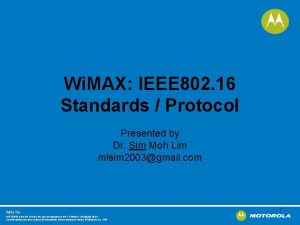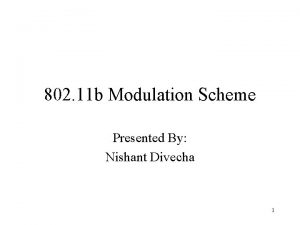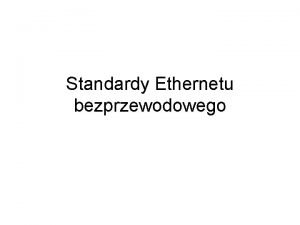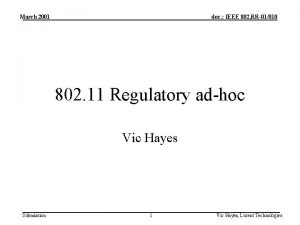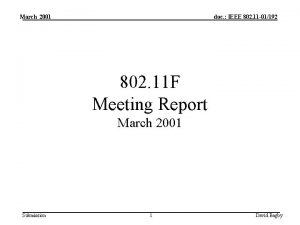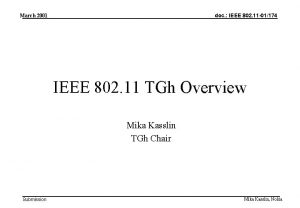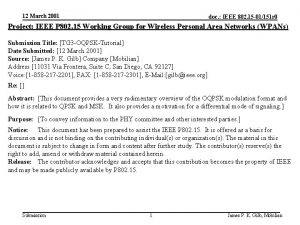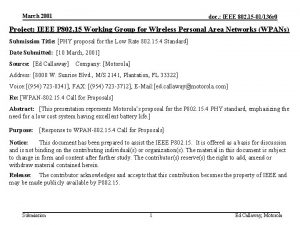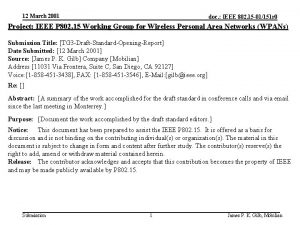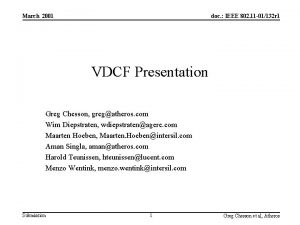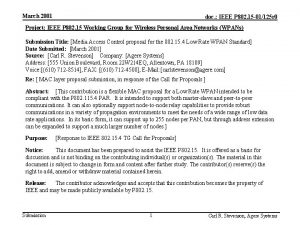March 2001 doc IEEE 802 15 01170 r














- Slides: 14

March 2001 doc. : IEEE 802. 15 -01/170 r 0 Project: IEEE P 802. 15 Working Group for Wireless Personal Area Networks (WPANs) Submission Title: Proposed Regulatory Approach for Unlicensed Bands Date Submitted: March 14, 2001 Source: Oren Eliezer Company: Texas Instruments Israel Address: POB 5133, Kfar-Saba 44150, Israel Phone: +972 -9 -7476962, Fax: +972 -9 -7430951, E-Mail: Oren. E@ti. com Re: Original Abstract: Various known or proposed coexistence mechanisms, which clearly serve to enhance systems’ coexistence performance in the unlicensed 2. 4 GHz band, and also successfully maximize the band usage in terms of capacity, through improved spectral efficiency, would not be allowed within the United States under current FCC regulations. On the other hand, other means of coexistence, which are not designed to maximize the band usage among multiple users, and could potentially cause considerable interference, are allowed. This current situation, obviously being in conflict with the interest of consumers, the industry, and the regulatory bodies, calls for a change that would better encourage efficient and “environment-friendly” use of the band. An evaluation method and derived regulatory approach, intended to achieve this, are presented herein. A more detailed proposal of the evaluation method will follow. Purpose: This presentation provides a spectral-usage evaluation measure in an attempt to define the optimal guidelines according to which systems should be allowed to use the unlicensed band, so as to allow coexisting users fair access of it and to maximize its capacity in that sense. Notice: This document has been prepared to assist the IEEE P 802. 15. It is offered as a basis for discussion and is not binding on the contributing individual(s) or organization(s). The material in this document is subject to change in form and content after further study. The contributor(s) reserve(s) the right to add, amend or withdraw material contained herein. Release: The contributor acknowledges and accepts that this contribution becomes the property of IEEE and may be made publicly available by P 802. 15. Submission 1 Oren Eliezer & Tom Siep, Texas Instruments

March 2001 doc. : IEEE 802. 15 -01/170 r 0 IEEE 802. 15 TG 2 Band Usage Evaluation and a Derived Proposed Regulatory Approach for Unlicensed Bands Hilton Head Island March 14, 2001 Oren Eliezer & Tom Siep Texas Instruments Submission 2 Oren Eliezer & Tom Siep, Texas Instruments

March 2001 doc. : IEEE 802. 15 -01/170 r 0 Outline • Background and History for FCC Part 15 – Comparison to regulations outside the USA – Examples of “unfriendly” transmissions that are allowed – Examples of friendlier transmissions that are not allowed • Developments in the FCC’s 15. 247 – Recent changes in the FCC’s 15. 247 – Initiation of rule making / evolving – Advantages of 802. 15. 2 in serving for that purpose • Evaluation of spectral usage efficiency • Maximization principle for fair sharing of the band • Proposed regulatory approach • Summary Submission 3 Oren Eliezer & Tom Siep, Texas Instruments

March 2001 doc. : IEEE 802. 15 -01/170 r 0 Comparison to Regulations Outside the USA • European and Japanese rules for frequency hopping transmissions in the 2. 4 GHz band allow more flexibility in the selection of channel bandwidth and number of hopping channels (such that only a fraction of the band is occupied allowing dynamic frequency replacements). • Levels of power allowed by FCC are generously high (1 Watt) for FHSS and DSSS systems (regardless of bandwidth), whereas other regulations limit power density. • No partition into application-limited sub-bands in the ISM bands, which could have offered some relief to coexistence issues (as with PCS, and in Europe). Submission 4 Oren Eliezer & Tom Siep, Texas Instruments

March 2001 doc. : IEEE 802. 15 -01/170 r 0 History • The fundamental approach within FCC’s Part 15 regulations and the various limitations defined in them were set forth long before the usage of this band, as anticipated today, became clearer. • Rules were written before “intelligent” schemes were considered (and subsequently modified to accommodate schemes such as adaptive hopping). • Various parameters within these regulations were updated several times in recent years, but there’s still room for improvement, in terms of maximizing the fair use of the band amongst multiple users. Submission 5 Oren Eliezer & Tom Siep, Texas Instruments

March 2001 doc. : IEEE 802. 15 -01/170 r 0 Examples of Currently Allowed(*) Transmissions which Could be Devastating Coexistence-wise – A frequency hopper, hopping over the entire band (similar to Bluetooth) could increase its power in an attempt to overcome interference (e. g. from 0 d. Bm to 20 d. Bm or even 30 d. Bm), contaminating the entire band for other users. – There is no restriction on transmission on/off ramping, which allows for generously high spurs caused at those instances in packet transmission (in-band spurs can be – 20 d. Bc). – A DSSS system could occupy the entire band, absolutely continuously, transmitting at power levels up to 1 Watt ! – There is no absolute or relative bandwidth limitation (relative = normalized to information rate), thus allowing waste of bandwidth. (*) Allowed within the USA according to FCC 15. 247 Submission 6 Oren Eliezer & Tom Siep, Texas Instruments

March 2001 doc. : IEEE 802. 15 -01/170 r 0 Examples of Effective Coexistence Mechanisms Currently not Allowed in the USA – The reduction in the number of hopping channels (below 75) for high power hoppers (e. g. 20 d. Bm or 30 d. Bm), to enable dynamic and flexible selection of clear hopping channels (intended to avoid other users in the band through detection of their presence). – Non-uniform use of hopping channels in a frequency hopper intended to concentrate more traffic on the clearer channels – Increase in channel bandwidth (e. g. to 2 MHz) in a frequency hopper (without occupying 75 MHz), intended to concentrate transmission in the clearer parts of the band. Submission 7 Oren Eliezer & Tom Siep, Texas Instruments

March 2001 doc. : IEEE 802. 15 -01/170 r 0 Recent Changes in FCC’s Regulation 15. 247 – The 20 d. B channel bandwidth, originally limited to 1 MHz, now widened to as much as 5 MHz (NPRM 99 -231) – The minimum number of hopping channels was reduced from 75 to as few as 15 (but only if an entire 75 MHz of band would be occupied? ) – Partial use of the hopping sequence allowed in bursty transmissions (15. 247 g) – Dynamic adaptation of the hopping sequence allowed (15. 247 h) Submission 8 Oren Eliezer & Tom Siep, Texas Instruments

March 2001 doc. : IEEE 802. 15 -01/170 r 0 Typical Initiation of Rule Making – A company or group of companies with common interest approaches the FCC to modify a rule that inhibits the introduction of a product they wish to launch in the USA. – Other companies or individuals may express their objection to the change and provide either technical reasoning, or “fairness” claims, or both. – The FCC examines the technical reasoning, both in favor and against the rule changing, and verifies potential consumer benefits. – After the process of evaluating all the inputs, the FCC defines the rule changing, according to what is believed to be in the public’s interest. Submission 9 Oren Eliezer & Tom Siep, Texas Instruments

March 2001 doc. : IEEE 802. 15 -01/170 r 0 Advantages of 802. 15. 2 TG in Proposing Changes (1/2) IEEE 802 Standards Principles • Due Process is through established rules and procedures. Each proposed standard (or recommended practice) undergoes two consecutive ballots: within the 802 Working Group and then to the technical community at large (through Sponsor Ballot). • Consensus is highly desired, near unanimity within 802 is generally the rule (90% approval encouraged). • Openness where all individuals, world-wide, have access to the process without membership or affiliation required. • Balance is maintained by having the Sponsor Ballot group include both developers and users. • Right to Appeal granted to anyone for both procedural and technical issues at any time during the process. Submission 10 Oren Eliezer & Tom Siep, Texas Instruments

March 2001 doc. : IEEE 802. 15 -01/170 r 0 Advantages of 802. 15. 2 TG in Proposing Changes (2/2) Group Members and Charter – The IEEE TG consists of high-level experts who have been dedicating much thought and work for over a year, for the purpose of enhancing the coexistence performance amongst users the 2. 4 GHz unlicensed band, thus maximizing its fair use among multiple users. – The FCC’s ultimate goal for the unlicensed band is to achieve exactly that ! – The TG’s work and conclusions are based on analysis, experimentation, and extensive high-level simulations, performed by individual contributors from various companies, universities, and the National Institute of Standards and Technology (NIST). – Conclusions of the IEEE TG, being based on these contributors, may be regarded as commercially neutral, and therefore technically reliable. Submission 11 Oren Eliezer & Tom Siep, Texas Instruments

March 2001 doc. : IEEE 802. 15 -01/170 r 0 Maximization of Spectrum Usage Efficiency – The goal of a transmission within a limited given time is to get a specific amount of information with a required quality of service across a time-varying channel (characterized by a time and frequency function representing both propagation losses and interference). – The system is assumed to be “competing” with other systems in the environment over the limited resources of the band, and is therefore expected to be efficient in its consumption of them. – The least power and time used to achieve the goal above, the more efficient the system is in its spectrum usage (spectral resources ~ bandwidth · time · power ) Submission 12 Oren Eliezer & Tom Siep, Texas Instruments

March 2001 doc. : IEEE 802. 15 -01/170 r 0 Proposed Regulatory Approach – Encourage technologies that offer high spectral efficiency. – Consider restricting specific sub-bands to specific standards (as already implemented in certain unlicensed bands). – Set limits to those parameters that are most strongly related to waste of spectrum resources, or could create the worst coexistence problems, e. g. : • Maximum power density (as in Europe) • Total instantaneous bandwidth occupied • Maximum bandwidth · time · power product of transmission • Maximum number of hopping channels used within a specific interval T Submission 13 Oren Eliezer & Tom Siep, Texas Instruments

March 2001 doc. : IEEE 802. 15 -01/170 r 0 Summary – Present regulatory situation has been shown to be suboptimal in terms of allowing the better coexistence mechanisms and inhibiting spectral abuse (examples have been provided to demonstrate that). – This situation is in conflict with the FCC’s interest, representing that of the public, regarding fair and maximized use of the unlicensed bands. – The spectral efficiency (”environment friendliness”) of a system has been proposed as a means for evaluating wireless systems. – Additional limitations were proposed to allow for enhanced coexistence amongst the users of the band to prevent spectral abuse. – The extensive work within IEEE 802. 15. 2 Task Group is proposed as guidelines to assist the regulatory bodies in their approval procedures for wireless systems operating in the unlicensed bands. Submission 14 Oren Eliezer & Tom Siep, Texas Instruments












